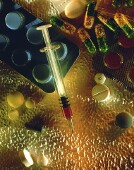 |
 |
 |

'Street' Drug Use Down, Rx Drug Abuse Rising: U.S. Report
Survey shows young adults moving away from coke, meth but toward prescription meds|
|
HealthDay
By Robert Preidt
Thursday, September 4, 2008
 THURSDAY, Sept. 4 (HealthDay News) -- Cocaine and methamphetamine use among young adults in the United States fell significantly in 2007, while abuse of prescription drugs increased fairly dramatically, according to a new U.S. survey.
THURSDAY, Sept. 4 (HealthDay News) -- Cocaine and methamphetamine use among young adults in the United States fell significantly in 2007, while abuse of prescription drugs increased fairly dramatically, according to a new U.S. survey.
The 2007 National Survey on Drug Use and Health, which included about 67,500 Americans, was released Thursday by the Substance Abuse and Mental Health Services Administration (SAMHSA).
From 2006 to 2007, cocaine use among adults ages 18-25 decreased 23 percent to 1.7 percent, the annual report found, and methamphetamine use fell by a third to 0.4 percent.
However, the abuse of prescription pain relievers by young adults rose 12 percent to 4.6 percent, according to the survey.
The poll also found a significant decline in overall past-month illicit drug use among youth ages 12-17 -- dropping from 11.6 percent in 2002 to 9.5 percent in 2007. There were reductions in the use of almost every type of illicit drug, including marijuana, cocaine, hallucinogens, LSD, Ecstasy and methamphetamine, and in the abuse of such prescription drugs as pain relievers.
Alcohol use in this age group decreased from 17.6 percent in 2002 to 15.9 percent in 2007 and cigarette use declined from 13.0 percent in 2002 to 9.8 percent in 2007, according to the report, released at the start of the 19th annual National Alcohol and Drug Addiction Recovery Month.
The reductions in cocaine and methamphetamine use among adults ages 18-25 coincide with reductions in their use among American workers.
Since 2005, there has been a 50 percent reduction in the level of workplace positive drug tests for methamphetamine. Pricing and quality for "meth" also underwent changes: according to the report, in 2007 there was an 84 percent increase in average price per pure gram and a 26 percent decrease in methamphetamine purity.
In 2007, the number of workplace positive drug tests for cocaine decreased 19 percent to the lowest levels in the history of the workplace testing system. Also in 2007, there was a 10 percent decrease in cocaine purity and a 21 percent increase in the average price per gram of the drug, the survey found.
The report did find that illicit drug use among older adults -- those aged 55 to 59 -- more than doubled, to 4.1 percent, in 2007. The finding seems to confirm that baby boomers have continued their higher levels of substance abuse as they age.
"Our efforts against methamphetamine, cocaine, and other illegal drugs are working," John Walters, director of National Drug Control Policy, said in a SAMHSA news release. "The markets for these poisons are shrinking, and the deadly grip they hold on the lives of individuals, families, and communities is being countered."
But, he added, "when it comes to prescription drugs, we cannot afford to re-live the painful experiences we've had with illegal drugs. We must act quickly to increase awareness of the dangers of prescription drug abuse, decrease the illegal diversion of these products, and shore up safer practices for their prescription and distribution."
The survey also examined mental health issues and found that 24.3 million Americans aged 18 or older experienced serious psychological distress and 16.5 million Americans suffered at least one episode of major depression in 2007.
There's a strong association between substance abuse and mental health, the report noted. For example, adults 18 and older who had a major bout of depression in 2007 were more than twice as likely as other adults to have used illicit drugs -- 27.4 percent vs. 12.8 percent.
HealthDay
Copyright (c) 2008 ScoutNews, LLC. All rights reserved.
Related News:
More News on this Date
Related MedlinePlus Pages:
| Home | Health Topics | Drugs & Supplements | Encyclopedia | Dictionary | News | Directories | Other Resources | |
| Disclaimers | Copyright | Privacy | Accessibility | Quality Guidelines U.S. National Library of Medicine, 8600 Rockville Pike, Bethesda, MD 20894 National Institutes of Health | Department of Health & Human Services |
Date last updated: 05 September 2008 |




